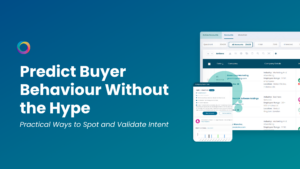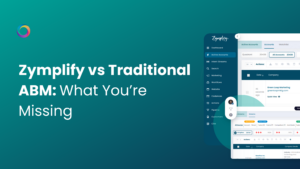Multichannel marketing is one of the most important marketing trends in 2019. There is a reason why you’re never more than two streets away from a Starbucks or a McDonalds. Being visible in more locations means more awareness, and more opportunity for your prospect to buy from you.
In terms of marketing, the same logic can be applied. Instead of only being visible in one place (e.g., your website), you should expand your reach across multiple channels, e.g., PPC, social media, email, SEO, etc.
Today’s prospects are much more educated than they were even five years ago – 90% of the buying process is over before a prospect ever speaks to a salesperson. Your perfect customers are on Google, checking review websites like G2 Crowd or Trust Pilot, looking through Facebook, Twitter LinkedIn, engaging with your competitors via email and through their websites.
In this multichannel world, it’s vital for brands to step away from the traditional marketing silo, and branch out into a more integrated, or ‘omnichannel’ approach.
Multichannel customers spend 3-4 times more than single-channel customers. Moreover, 74% of businesses found they increased their sales using a multichannel strategy.
What is Multichannel Marketing?
Multichannel marketing refers to the practice of engaging prospects, leads and clients across a range of channels. A channel could be a device, a medium, a network – it’s any touchpoint you can have with your ideal customer. For example:
– Your website
– Pay-per-click (PPC)
– Social media
– Your sales agents (or partners)
– Direct mail
– Your app
– Blogging
– SMS
– TV
– Radio
– Physical stores
Multichannel marketing is vital for your business, as it allows you to be everywhere your customers are.
Your multichannel approach must be a completely seamless experience for your customers, regardless of the channel.
For example, a prospect that is at the top of the funnel, shouldn’t get an email from you containing a case study, as they aren’t ready for that type of content when they are at that particular stage of their buyer journey.
Ideally, it would help if you used behaviourally targeted messaging, across all your channels, according to the actions that particular prospect/client has carried out. An example of this:
– A prospect has filled in a form on your website to download a piece of content, specific to the manufacturing sector.
– They should then only receive messages from your brand, that is specific to their particular industry, e.g., ads on Facebook/Google, email comms, should all be specific to the manufacturing sector.
Buyers want to feel like they are in complete control of their sales journey – prospects no longer like to be sold to. There are more channels, more devices and more options available to them than ever before. This is why it is critical to ensure your multichannel strategy provides an authentic, seamless experience across all channels, so when the time is right, your prospects are ready to buy from you.
Why should you use Multichannel Marketing?
Billboard ads or print media are no longer as effective as they once were. Not least because tracking the results of marketing spend using these traditional mediums is much harder than through digital channels.
Now marketers have to market through all their channels to ensure their message is seen by the right person, at the right time, at the right stage of their buyer journey, regardless of the channel.
With so many touchpoints and strategies to orchestrate, how can marketers better coordinate their efforts?
Multichannel marketing automation software (like Zymplify) gives businesses the tools they need to build and execute multichannel campaigns, across all their channels, whether that’s social media, PPC, email or more. Multichannel marketing automation software allows marketers to launch their campaigns and manage them in real-time while attributing the results to the right channel.
This means marketers have a single ‘decision engine’ to ensure the right message is delivered via the best channel, to suit the behaviour of the prospect/client.
There are many other reasons why it’s beneficial for marketers to use multichannel marketing. Here are a few:
To Boost Sales
By connecting with your prospects through many channels, through their buying journey, you are driving your message more than if you were utilizing a single channel. A multichannel approach gives more people a chance to purchase more products and gives your brand far greater audience visibility. Brands that use a multichannel strategy gain up to 300% improvement in ROI from their advertising efforts, resulting from a 24% increase in conversion rates as more targeted prospects see behaviourally specific ads from multiple channels.
Cost Effectiveness
Basing future marketing on reliable data means that marketers who use a multichannel strategy can organize their resources more efficiently and effectively. Marketers can implement cost-effective strategies to engage and connect with their customers across multiple channels, resulting in faster and better returns for their investment in marketing strategies.
Respond Quickly to Customer Trends
Today’s consumers have more methods of connecting with businesses than ever before – and your brand must respond to customer demands. Connecting with customers via multiple channels means that customers have more opportunities for engagement, and your business has more opportunities to nurture the customer relationship and increase customer satisfaction, using the channel that best suits customer preference.
How to Plan an Effective Multichannel Marketing Strategy
Organizations using an effective integrated multichannel marketing plan will continuously stand out, gain qualified leads and maximize conversion throughout the customer lifecycle. Your multichannel marketing plan should therefore continually engage, nurture and retarget customers to convert to a sale. A multichannel marketing strategy typically includes:
– Detailed customer personas and details on their buying journey.
– Information on the different channels these personas utilize when journeying through their buying funnel.
– A content plan for the different types of content that will resonate with each persona through their buying journey, with an inbound focus.
– SMART objectives for acquiring and retaining customers.
– The integrated marketing communication channels to be utilized, across multiple platforms and devices to attract and convert customers, as well as the campaigns/content that will be used, keeping the buyer journey in mind throughout.
– The KPIs that will be used to measure effectiveness, influencer and exclusion.
Knowing which campaigns on which channels has led to the most sales will enable you to establish the success of your activities and the ROI that each particular channel returns. Customers move across channels quickly. Therefore, both your strategy and analytics should simultaneously adapt – seamlessly.
Top 10 Tips for Multichannel Marketing
The following tips are designed to help your brand plan and operate a successful multichannel strategy – but it’s vital to adapt and change to match your customer and as your analytics come to light.
1. Remember your customer
The heart of a multichannel strategy is to allow the customer to interact with you as they choose. Therefore, your brand must have the customer at the heart of your strategy. If you decide to put the brand’s needs/wants first, it will provide an inauthentic experience for your customer, they will quickly smell a rat, and your strategy will quickly fail.
2. Remember – these are your best customers
As stated above, multichannel customers are more profitable than other customers, so treat them well. Having multiple channels will help you attract these more profitable clients, so it’s vital to ensure your marketing strategy flaunts your businesses’ USP.
3. Test, test and test again
In this world of real-time customer experience, testing helps to make sure you put the best possible foot forward and gives you the best chance of being relevant. Guesswork is both a waste of time and energy and an easy way to ensure your interactions aren’t as effective as they should be. Instead, let user data decide definitely which campaigns will deliver the most for your brand.
4. Provide a seamless experience
As mentioned throughout this blog, it is vital to provide a seamless experience across all your channels. This means that your brand must not give an experience on one channel that’s different to another – which can be challenging to manage. However, utilizing multichannel marketing automation software like Zymplify can help you manage your strategy quickly and easily, ensuring that each prospect’s behaviour is accounted for and marketer to correctly – regardless of the channel.
5. Campaigns that work together stick together!
One campaign on its own can be effective, but when two or more work together, they deliver even more excellent results. That’s why it is vital to consider the effect that anyone campaign may have on the others around it, and to build campaign flows around the user. It’s also important to remember that users are unique – so rather than force them through pre-defined customer journeys, try to deliver real-time, dynamic content to each, throughout their buying journey.
6. Focus on what matters
Every marketing department has KPIs, which relate to the overall company’s business goals, and ultimately, those KPIs add up to revenue. That’s why focusing on conversions is a great place to start. Using behavioural data to target users with comms that you know they have shown an interest in will significantly drive revenue. Once again – providing a seamless experience across all your multichannel campaigns is critical.
7. Get your timing right
The ‘right’ time can take many forms – a message triggered by a consumer’s actions, such as an abandoned cart, or opening a particular email. Triggers like these can take away the feeling of being spammed, and consumers are twice as likely to engage as a result – as they feel like the message is relevant to them, and the time is right in their buying journey.
If the message is targeted and triggered, behavioural data can decide when the optimal time is the deliver a message to individual consumers, with the highest likelihood of being relevant at that particular time.
8. Price the channel in relation to cost
If your product’s pricing changes, it’s important to remember to offer your best price via the channel with the lowest associated costs. If you don’t do this, you will be left with the most business in your highest cost channel where you will make less margin because you are cheaper than the competition. At the same time, you will have less business in your low-cost channel where you are too expensive.
9. Utilize multichannel marketing automation software, like Zymplify
Multichannel marketing automation software allows you to launch, manage and view all your data from each of your different channels in the one place. This is the absolute number one key to success. Instead of drowning in data and trying to pull stats from all your different channels, marketing automation software allows you to have a comprehensive user profile for each of your campaigns, per channel, and per customer. You can view everything from CTR (click through rate), CR (conversion rate), number of leads, number of sales, and so much more. You will know precisely what campaigns, on which channel are working for your brand, and what is creating a return. So you can do more of what you’re good at!
10. Have a clear goal
This might seem obvious, but many marketers start a multichannel campaign with no goal in mind – meaning they won’t know if they’re successful as there’s no benchmark to measure against. Every campaign has a different goal – it could be to gather leads, increase blog engagement, or re-engage with lost users, or encourage return spenders. Whatever it may be, you need to have a clear understanding of your goals, per channel so you can plan every part of your multichannel campaign with a clear understanding of your measure of success.
Conclusion
With multiple channels in play, it is vital to measure results carefully throughout the duration of your campaigns continually. However, if your brand keeps your customer at the forefront of your strategy, you can be guaranteed of success.
Planning a successful multichannel marketing plan takes careful planning, time and effort. However, a multichannel marketing automation platform will help you manage your campaigns the easy way – regardless of, however, many channels, you’re planning to launch on.
More from Zymplify
Ten steps to take for effective SEO



